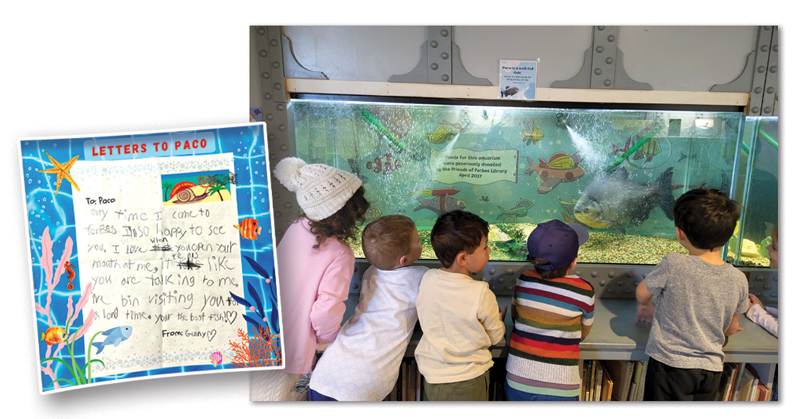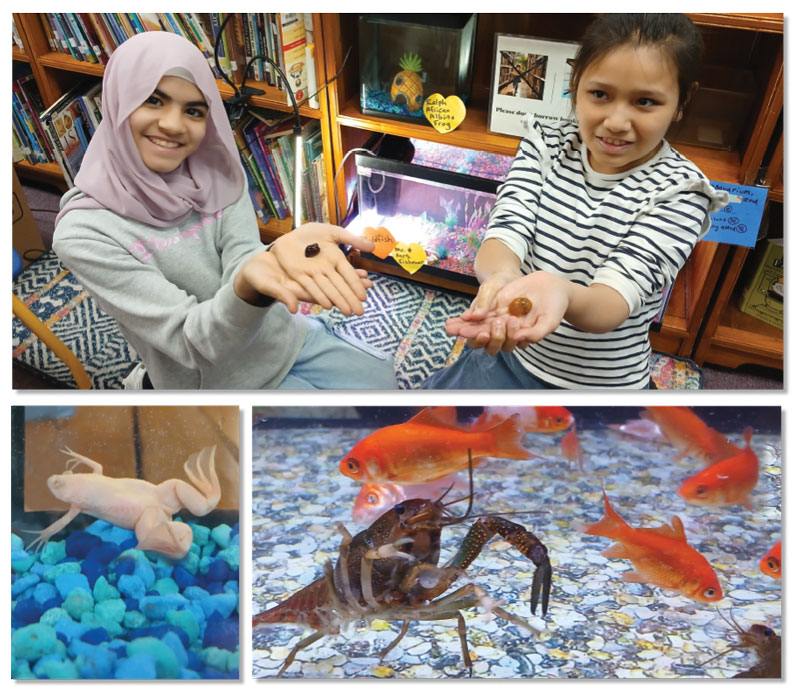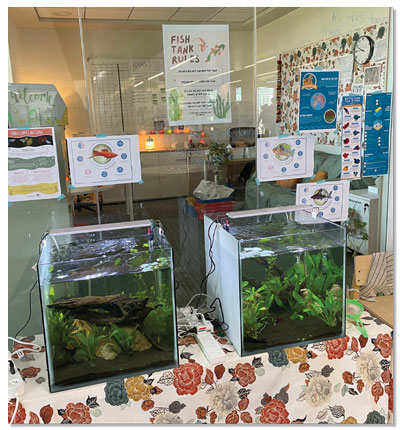The Joy and Responsibility of Library Aquariums
Fish, frogs, and other aquarium life at school and public libraries entertain and offer lessons in science and responsibility.
 |
Paco received dozens of letters through a “Letters to Paco” program; Local legend and South American Pacu fish Paco greets preschool students prior to a story time at Forbes Library (Northampton, MA).Photo by Sarah Johnson |
At Forbes Library in Northampton, MA, children clamor to attend story time and crafts with Paco, the public library’s 38-year-old pacu fish. Swimming around a 240-gallon tank in a submarine-themed children’s room, Paco has “hosted” events for more than three decades. Many parents and caregivers fondly remember growing up with Paco and can’t believe their children get to meet the same fish they did.
A two-foot-long South American pacu fish, Paco is related to the piranha, but instead of sharp, pointy teeth, Paco has a turned-up mouth that gives her a perpetual smile as she swims toward visitors.
“I hear children say ‘Paco!’ ‘Paco!’ in the stairway,” says Sarah Johnson, head of children’s and YA services at Forbes. Kids especially love to see librarians feed Paco a healthy diet of fish flakes, bananas, grapes, and raspberries. The library sells Paco-themed T-shirts and offers Paco stickers at story time, and fans avidly follow the fish’s posts on Forbes’s Instagram. Johnson posts informational signs about Paco and has noticed an uptick in circulation of books about piranhas when she puts up a book display near the fish tank.
Paco has been at Forbes longer than anyone on the library staff, and she represents the spirit of this small-town library near the Smith College campus. When Forbes librarians visit local schools, children often ask, “Where’s Paco?”
According to the Smithsonian National Zoo and Conservation Institute, pacu are expected to live 15 years, but Paco has almost doubled that lifespan because of the library’s devoted and methodical care. Thirty years ago, Paco joined the library through Russell Wall, owner of Exotic Aquarium and Pond Service in Easthampton, MA. When one of his customers was unable to care for Paco, Wall offered to rehome her—and Forbes accepted, under the condition that Wall would provide her setup and ongoing care. Wall has been on Team Paco ever since, servicing the tank by testing the water chemistry, maintaining filtration, and providing input on Paco’s feeding and health. Paco thrives because she has been cared for by the same person most of her life, and her care is well-informed, well-researched, and well-coordinated.
The librarians toss food into Paco’s tank, but Wall is responsible for almost everything else. Wall, who has extensive experience setting up aquariums for businesses, cautions that it’s harmful to the animals when too many people are involved. And he recommends that if a school sets up its own aquarium, one person serve as the lead caregiver, with up to two others helping, following clear, easy instructions. Regardless of the species, fish require at least 30 to 40 minutes of care per week.
Thriving, not just surviving
Beyond the obvious enjoyment that fish and other aquatic animals bring to children in libraries, they also provide spontaneous lessons about science, sustainability, the awesomeness of nature, and people’s responsibility to care for animals. Over the last two years, librarian Haley Kemper at the ABA Oman International School in Muscat, Oman, a PreK–12 International Baccalaureate Continuum School serving 950 students from more than 60 countries, has learned about fish care by helping other teachers and staff rehabilitate aquatic animals that weren’t thriving in small or inadequate tanks. Recently, Kemper’s aquarium has boasted tiger and leopard guppies, koi swordtails, a featherfin catfish, German blue rams, a blue crayfish (which ate the blue rams), betta fish, and cherry shrimp.
Kemper’s first “rescues” were a trio of goldfish crammed into a tiny bowl on a staff member’s desk. “The water was so cloudy, you could barely see them,” the librarian recalls. After doing some quick research, Kemper realized that the goldfish required much more space and water filtration. Goldfish are considered fragile, but if well cared for, they can live for decades—though they do dirty their tanks quickly. One betta fish can remain cleaner than a goldfish for a longer time in the same-size tank. (And goldfish and bettas should not be placed in the same tank, since bettas are aggressive and would kill goldfish).
When Kemper rehomed her colleague’s goldfish in a larger tank, she conditioned the water to remove chlorine and nitrates, and added proper filters and oxygenation. “There was so much to learn,” Kemper says. Her students, from a variety of cultures, learned alongside her. Many students have some experience with, and knowledge about, fish, and want to know more. And children who are having a bad day tend to gravitate to bubbling aquariums with bright, peaceful fish, she says.
Kemper also rescued a beautiful blue and red halfmoon betta living in a drinking glass, and a blue delta betta fish living in a very small bowl after learning they need “at least 2.5-gallon tanks [and] places to rest near the surface of the water.” Bettas are labyrinth fish, so they rise to the surface to breathe air and require plants or floating leaves they can lounge on like couches. They also prefer warmer water temperatures, so a heater and filter increase their lifespans.
One teacher at Kemper’s school brought her whole class on a “fish field trip” to the library, where they were able to check out fish books and learn how to properly care for fish. Students have even observed Kemper rehabilitating fish whose fins were nipped and then grew back.
 |
At OWN, students with live snails; Ralph, an Albino African clawed frog; and King Tiger, a tiger pistol shrimp.Courtesy of Our World Neighborhood Charter Schools |
Animal care clubs
At the Our World Neighborhood (OWN) Elementary and Middle Schools in Astoria and Long Island City, NY, where I run two libraries, students can sign up for “Animal Care” as their weekly enrichment or club activity, or help me attend to fish during recess. As an International Baccalaureate School, OWN emphasizes citizenship, responsibility, and friendship as Pillars of Learning, social fundamentals I teach to my students as we collaborate on fish care. As my students work together to clean a large tank, they often bring different points of view. Conflicts can arise, and I am there to help students learn to work things out. Identifying one’s strengths, finding one’s role in a team, and learning to make compromises are lifelong skills that students build in Animal Care.
At the middle school, Animal Care leaders Ryan Gonzalez, a science teacher, and Jessica Petro, information and communication technology teacher, make a spreadsheet of the aquatic pets in the building—including turtles, tadpoles, water frogs, fish, and snails—and train and supervise students in proper care. I’m one of several teachers (and a guidance counselor) with fish registered on Petro and Gonzalez’s list.
During one 45-minute enrichment period every week, students change tank water, feed animals, and replace filters. And, depending on the animals’ needs, students may also feed them one or two more times a week.
At OWN, I care for a 40-gallon tank of four female betta fish (females can live together while the more aggressive males must live alone); a 40-gallon tank of two rapidly growing goldfish; and a five-gallon tank that houses an albino African clawed frog that lives entirely underwater, coming to the surface only for quick breaths. Recently we also adopted seven grass frog tadpoles, which swim in two small tanks but, when mature, will require tanks that are half wet and half dry. At the elementary campus, I use a document camera to project images of the growing tadpoles on the Promethean Board. This builds excitement and curiosity among students about visiting the library.
 |
Planted tanks at the ABA Oman International SchoolCourtesy of Haley Kemper |
Sustainability and science learning
Librarian Adrienne Marriott was a science teacher for 12 years at Bonita Vista High School in Chula Vista, CA, before she became a librarian there two years ago. Her science background prepared her to engage with curious students about the library’s aquaponic garden. In such a setting, plants grow on top of a fish tank or pond, and circulating water helps the animal waste fertilize the plants.
Marriott’s Title 1 school serves 1,900 students, most of Latinx background. Marriott says conversations about fish can be a great “relationship builder” and help students feel more comfortable in the library. Marriott has used signage about aquaponics in her former science lab and library, and is planning to introduce learning exhibits about aquaponics. “I plan to find or create an infographic, maybe tie it in to nitrogen cycles, and add information about how aquaponics can be used at larger scale to grow fish—usually tilapia—for human consumption,” says Marriott. Students learn that aquaponic tanks don’t require a filter because the plants provide a natural one. It’s a great lesson about sustainability and the interconnectedness of natural systems.
At Forbes Library, Johnson invited Kelly Walbert, family programs educator at Mass Audubon Arcadia Wildlife Sanctuary, to offer a drop-in “Arts and Crafts with Paco” event to teach children about pacu fish (or colossoma brachypomus). Walbert’s goal was to introduce learners to Paco’s natural habitat, life cycle, and adaptations through a presentation and crafts. Families explored three crafting stations: They wrote and illustrated letters to Paco for a community “We Love Paco!” banner, folded origami fish and created a thumbprint fish by pressing their fingers into ink, making prints, and drawing eyes, fins, and tails.
Walbert’s aim was to help children identify and understand the unique features of pacu fish. “For instance, while making origami fish, we chatted about gills and various types of fins. In our thumbprint activity, the kids got creative by brainstorming characteristics of different fish habitats and picked one to bring to life,” says Walbert.
“Lots of children can’t have a pet for various reasons, and Paco is Northampton’s pet,” Johnson says. “It’s special, the bond she has with so many kids.” And the affection students feel for a fish can help them build a lasting relationship with a library.
Paco also put Forbes on the map, distinguishing it from all the other libraries in the area. When Johnson introduces herself, she now says, “I work at the library where Paco lives.”
How to Keep Fish Healthy
Give fish lots of space. It might sound obvious, but when fewer fish occupy a tank, there is less waste to clean. Similarly, the bigger the tank, the cleaner the water. We may be accustomed to seeing pet store aquariums crowded with fish, but this isn’t healthy for the long term. When purchasing fish, ask how many gallons of water each fish should ideally have, and then err on the plus side. Two goldfish will enjoy a spacious 40-gallon tank, and they will grow to fill it. Decorate the tank with plants, figurines, and bubblers, and the two active, healthy fish will entertain students as much as a whole school of fish would. Change the water frequently and partially. Russell Wall, owner of Exotic Aquarium and Pond Service in Easthampton, MA, recommends doing partial water changes to keep tanks clean: 10 percent of the water if changing it weekly, or 20 percent if biweekly. Changing more than 25 percent of the water at one time is too much. Partial water changes make it easier for children to help because they don’t have to catch and remove the fish. Give extra-large used takeout iced coffee or soda cups to three or four students; have them scoop out the dirty water, dump it into a toilet, and replace it with clean water from a water fountain, adding water conditioner to remove chlorine. Arrange for vacation and weekend feeding. Wall advises avoiding vacation feeder tablets or stones because they can dissolve at an unpredictable pace and might overfeed or underfeed fish. They can also dirty the water, which can be hazardous. Instead, Wall recommends Eheim Feed-Air Fish Feeders (available on Amazon), which dispense food on a timer. If you’ll be away for a weekend, he says, it might be best to skip the feeding entirely. During long vacations and over the summer, some educators send animals home with responsible students and their families with detailed instructions. Consider an aquaponic garden. This may be easier to maintain than a fish tank, says librarian Adrienne Marriott, because “plants clean up the fish waste so you don’t have to worry about filter changes.” Marriott recommends AquaSprouts kits (available on Amazon and through DonorsChoose grants) and the Ecolife Conservation aquaponics curriculum (bit.ly/4jcUh5Y). Use fresh food as a supplement. Betta will sometimes feed on live plants or small live shrimp such as GreenWaterFarm Fairy Shrimp Thailandensis Eggs (sold on Amazon). Live food might be a good choice during long weekends or other absences. Hatch the shrimp in a separate container with filtered spring water, then add a few at a time to the fish tank. Do not leave live food as the only nutrient source while you are away if you haven’t tested it to make sure your betta can capture and eat the shrimp. Look for nature’s vacuum cleaners. Snails, catfish, fairy shrimp, and other bottom feeders keep tanks clean naturally. They don’t replace regular tank cleanings but can be a great help. Children can also observe how every aquatic creature has its own role in the community, a great lesson to learn. |
Jess deCourcy Hinds is a librarian at two International Baccalaureate campuses of the Our World Neighborhood Charter School, serving elementary and middle school students in Queens, NY.
RELATED
The job outlook in 2030: Librarians will be in demand
The job outlook in 2030: Librarians will be in demand
ALREADY A SUBSCRIBER? LOG IN
We are currently offering this content for free. Sign up now to activate your personal profile, where you can save articles for future viewing







Add Comment :-
Be the first reader to comment.
Comment Policy:
Comment should not be empty !!!